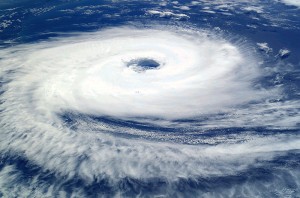
Typically known as typhoons in the Western North Pacific and cyclones in the Indian Ocean, hurricanes are juggernautic storms that can lash sustained winds exceeding 254 km per hour while unleashing more than 9 trillion gallons of water a day. Hurricanes start out as tropical depressions, with a wind speed of 61 km per hour, escalating onto tropical storms and on gaining wind speed; it redefines itself into a hurricane leaving behind in its path a wanton destruction of the environment.
- Based on the Saffir-Simpson scale, hurricanes are categorised from 1 to 5 with 1 being the least damaging and 5 causing catastrophic damage.
- Originally called   ‘˜Huracan’, a Carib Indian word, it was changed to ‘˜hurricane’ by Spanish colonists.
- Initially, meteorologists referred to hurricanes by longitude and latitude to facilitate tracking. Â However as this posed confusion to people tracking hurricanes, the intriguing option of using unique identifiers i.e. names was put into practise. The initial list, in 1953, contained English, Spanish and French female names. This was altered in 1979, to include male names. There are six lists of 21 alphabetically arranged names, annually rotated. Â Devastating hurricane names are retired and replaced with a new name e.g. Andrew was replaced by Alex.
- Hurricanes rotate counter-clockwise in the Northern Hemisphere and clockwise in the Southern Hemisphere. This is due to a force originating from its rotation, called the Coriolis force, which deflects wind in the Northern hemisphere to the right and to the left in the Southern Hemisphere. Â When a low pressure area builds up, wind which flows to replace the low pressure area is deflected to the right and this will result in a counter clockwise movement. (or vice versa).
- The requisites for a hurricanes are moisture, temperatures of more than 810F, high humidity and appropriate wind shear for it to gain strength and develop from a storm to a hurricane.
- Hurricane hunters from the  Air Force Reserve and the  National Oceanic and Atmospheric Administration (NOAA) provide first hand information on a hurricane by flying into it.
- The centre of a hurricane is called the ‘˜eye’ and it is surrounded by a structure called the eyewall. The eye consists of the area of lowest pressure and highest temperature. Eyes can extend from 8 km to over 200km although the average eyes range from 30-60km in diameter.
- Environmental studies indicate that the sustained long-term negative impact of hurricanes depends on the intensity of the hurricane. Dry hurricanes (Andrew, 1992) did not impact the environment as much as wetter; slow moving ones which can inundate large areas of the environment with salt water, destroying all vegetation in the process. Water flows can be changed permanently. There have been incidents where non-native plants were found far away from their original place of habitat impacting the ecological balance e.g. Hurricane Donna spread seeds of the Australian tree Casuarinas up the west coast of Everglades National Park in 1960.
- Red Spot is a hurricane on Jupiter that has been in existence since it was observed 400 years ago. Â Due to a lack of land mass, its heat is not dissipated plus the fact that it is driven by Jupiter’s internal heat ensures the continued existence of this hurricane.
- Hurricanes contain a huge amount of potential energy. The amount of kinetic energy generated by a mature hurricane is equivalent to half the world’s generating capacity.










Leave a Reply